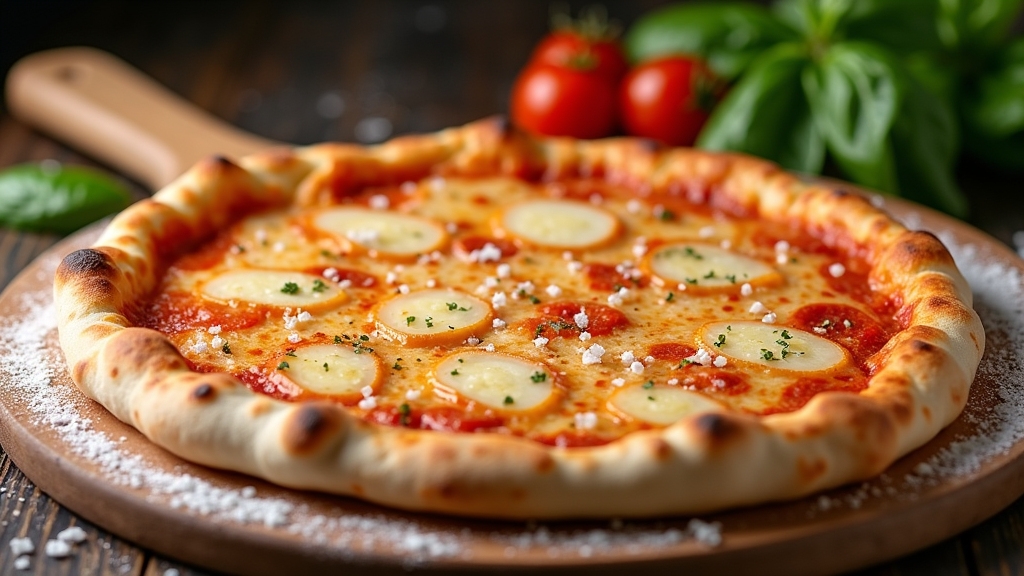I’ve got an easy and delicious pizza crust recipe that anyone can master! First, mix warm water with active dry yeast and let it sit. Then, knead flour, olive oil, sugar, and salt with the yeast mixture until smooth. Let it rise until doubled in size and shape it into your desired pizza base. Top with your favorite ingredients and bake for a golden finish. If you stick around, I’ll share some tips to enhance your pizza experience!
History
When I plunge into the history of pizza crust, I can’t help but marvel at how this simple dough has evolved over centuries. Its ancient origins trace back to the flatbreads enjoyed by ancient civilizations like the Egyptians and Greeks, who topped them with various ingredients. As I explore further, I discover the rich tapestry of regional variations, from the thin, crispy crusts of Neapolitan pizza to the thick, hearty styles found in Chicago. Each style reflects the local culture and culinary innovations, showcasing a fascinating journey of flavors and techniques. It’s incredible to think how this humble dough has transformed into a global phenomenon, sparking creativity and passion in kitchens around the world.
Recipe
Making your own pizza crust at home can be a rewarding experience, and it’s simpler than you might think! A homemade pizza crust allows you to customize your pizza to your liking, whether you prefer a thick, chewy base or a thin, crispy one. The key to a great crust lies in using high-quality ingredients and allowing the dough to rise properly, which enhances the flavor and texture.
This recipe will guide you through creating a classic pizza dough that can be made ahead of time or used immediately. With just a few simple ingredients, you can whip up a delicious crust that serves as the perfect foundation for all your favorite toppings. Let’s plunge into the ingredients you’ll need to get started!
Ingredients:
- 2 ¼ teaspoons active dry yeast
- 1 ½ cups warm water (110°F)
- 3 ½ to 4 cups all-purpose flour
- 2 tablespoons olive oil
- 1 teaspoon sugar
- 1 teaspoon salt
To prepare the dough, begin by dissolving the yeast and sugar in the warm water and allow it to sit for about 5-10 minutes until it becomes frothy. In a large mixing bowl, combine 3 ½ cups of flour and salt. Make a well in the center and add the yeast mixture along with the olive oil. Stir the mixture until a sticky dough forms. If the dough is too sticky, gradually add the remaining flour until it reaches a manageable consistency. Knead the dough on a floured surface for about 5-7 minutes until it becomes smooth and elastic. Place the dough in a greased bowl, cover it with a damp cloth, and let it rise in a warm place for about 1 hour or until it has doubled in size.
For the best results, be sure to preheat your oven to the highest temperature for at least 30 minutes before baking your pizza. A pizza stone can also enhance the crust’s texture, as it retains heat and creates a crispy bottom. If you like a flavored crust, consider adding herbs or garlic powder into the dough. Once your dough has risen and you’re ready to bake, roll it out to your desired thickness, add your favorite sauce and toppings, and enjoy a homemade pizza that’s sure to impress!
Cooking Steps
Now that we’ve got our ingredients ready, let’s jump into the cooking steps that will turn our dough into a delicious pizza crust. I’ll guide you through mixing warm water and yeast, kneading the dough until it’s smooth, and letting it rise to perfection. From shaping the dough to adding your favorite toppings, each step is essential for creating that mouthwatering base.
Step 1. Mix Warm Water and Yeast
To kick off the pizza crust process, I warm some water until it feels pleasantly warm to the touch, not hot enough to scald. This warm water is essential for yeast activation; it creates the perfect environment for those little organisms to flourish. I pour the warm water into a mixing bowl and sprinkle in the yeast, watching as it gently dissolves and begins to bubble. That bubbling is a sign of life, and it fills me with excitement—it means my dough will rise beautifully. I let the mixture sit for about five minutes, allowing the yeast to awaken fully. This simple yet significant step sets the stage for a crust that’s both flavorful and airy, ready to hold all my favorite toppings.
Step 2. Knead Dough Until Smooth
With my yeast mixture bubbling happily, I sift in the flour and sprinkle in a pinch of salt, ready to bring it all together. As I mix, I can feel the dough starting to take shape. Once combined, it’s time for the kneading techniques that will transform my mixture into a smooth ball. I press and fold, using the palms of my hands to work the dough. This is where the magic happens—each push helps develop the gluten, creating a beautiful dough texture that feels elastic. After about 8-10 minutes of kneading, I know it’s ready when it springs back after a gentle poke. This step is essential for achieving that perfect crust, so don’t rush it!
Step 3. Let Dough Rise Covered
After kneading the dough until it’s smooth and elastic, I place it in a lightly greased bowl and cover it with a damp cloth. This step is essential for allowing the dough to rise properly, enhancing its flavor and texture through fermentation. I usually let it rise in a warm spot, which helps speed up the rise time. If you’re looking for dough fermentation tips, try placing the bowl in the oven with just the light on; it creates a cozy environment. I check the dough after about an hour; it should have doubled in size. Once it’s risen, I can’t wait to shape it into the perfect pizza base! This is where the magic really begins.
Step 4. Shape Dough Into Pizza Base
Once the dough has risen beautifully, I can’t help but feel excited as I gently punch it down to release any trapped air. Next, I sprinkle flour on my countertop, preparing for some serious dough shaping. I divide the dough into equal portions, rolling each one into a ball. Using my fingertips, I start pressing from the center outward, employing classic pizza techniques to create that perfect base—fluffy on the edges and slightly thinner in the center. I love the feel of the dough stretching beneath my hands, and I keep it moving, ensuring it doesn’t stick. With each motion, I can visualize the delicious pizza to come, making this step utterly rewarding and essential for the perfect crust!
Step 5. Add Toppings of Choice
Now that the dough is shaped into a perfect base, it’s time to release creativity with toppings. This is where the magic happens! I love mixing and matching my favorite toppings to create delicious topping combinations that excite the palate. Here are some ideas to get you started:
- Classic Margherita: Fresh mozzarella, basil leaves, and a drizzle of olive oil.
- Spicy BBQ Chicken: Grilled chicken, tangy BBQ sauce, red onions, and cilantro.
- Mediterranean Delight: Feta cheese, Kalamata olives, artichoke hearts, and sun-dried tomatoes.
Feel free to get adventurous! Layer on those vibrant veggies or experiment with unique cheeses. The possibilities are endless, so trust your instincts and enjoy the process. Happy topping!
Nutritional Guide
Understanding the nutritional aspects of your pizza crust can transform your homemade meal into a healthier option. By selecting the right ingredients, you not only enhance flavor but also boost the crust’s health benefits. For instance, whole wheat flour offers more fiber, while using olive oil can provide healthy fats. Here’s a quick look at the caloric content and ingredient benefits:
| Ingredient | Caloric Content (per serving) | Benefits |
|---|---|---|
| Whole Wheat Flour | 90 calories | High in fiber |
| Olive Oil | 120 calories | Heart-healthy fats |
| Yeast | 25 calories | Supports digestion |
| Water | 0 calories | Hydration and texture |
Final Thoughts
Creating a delicious pizza crust is more than just following a recipe; it’s about making choices that can enhance both flavor and health. My personal experiences in the kitchen have taught me that even small tweaks can make a big difference. Here are my final thoughts on crafting the perfect crust:
- Experiment with Flours: Don’t hesitate to mix whole wheat or alternative flours for added nutrition.
- Incorporate Herbs: Adding dried herbs like oregano or basil can elevate your crust’s flavor profile.
- Control the Thickness: Whether you prefer thin and crispy or thick and chewy, adjusting the dough’s thickness is key.
Frequently Asked Questions
Can I Use Whole Wheat Flour Instead of All-Purpose Flour?
Absolutely, I’ve swapped all-purpose flour for whole wheat flour before. The benefits are fantastic—it’s healthier! Just remember, the texture might be denser, but it adds a delightful, nutty flavor that’s worth experimenting with.
How Can I Make Gluten-Free Pizza Crust?
I never thought I’d crave gluten-free pizza crust, but here I am! For delicious variations, I use almond flour or cauliflower as gluten-free alternatives. It’s surprisingly tasty, and my friends can’t even tell the difference!
What Toppings Pair Well With This Pizza Crust?
When I craft my pizza, I love experimenting with cheese options like mozzarella and goat cheese. For veggie toppings, roasted red peppers and fresh arugula add amazing flavor, making each bite a delightful innovation. Enjoy!
How Do I Store Leftover Pizza Crust?
Think of leftover pizza crust like a treasure waiting to be preserved! For crust freshness, I wrap it tightly in plastic wrap and store it in the fridge, or freeze it for longer-lasting enjoyment. Storing tips are key!
Can I Freeze the Pizza Dough for Later Use?
Absolutely, I freeze my pizza dough all the time! For freezing tips, I wrap it tightly in plastic wrap and store it in an airtight container. This guarantees freshness and makes dough storage a breeze for later use!
Conclusion
As I wrap up this journey into the world of pizza crust, I can’t help but marvel at the fact that over 3 billion pizzas are sold each year in the U.S. alone! It’s a proof of our love for this versatile dish. Whether you opt for thin and crispy or thick and chewy, making your own crust not only enhances the flavor but also allows for a personal touch. So grab your ingredients, and let’s make pizza magic happen!

Pizza Crust Recipe Easy
Ingredients
Equipment
Method
- Activate Yeast: In a bowl, mix warm water, sugar, and yeast. Let sit for 5-10 minutes until frothy. (Skip if using instant yeast.)
- Mix Dry Ingredients: Whisk flour and salt in a large bowl.
- Combine: Add yeast mixture and olive oil to the flour. Stir until a shaggy dough forms.
- Knead: Turn onto a floured surface and knead for 5 minutes until smooth and elastic. (Too sticky? Add 1 tbsp flour at a time.)
- Rest: Cover dough with a towel and let rise for 1 hour (or skip for thin crust).
- Preheat: Preheat oven to 475°F (245°C). Place a baking sheet or stone inside to heat.
- Shape: Divide dough in half. Roll out or stretch by hand into 12-inch circles.
- Bake: Transfer to parchment or a hot baking sheet. Pre-bake for 5 minutes (optional for crispiness), then add toppings and bake 8-10 minutes until golden.
Notes
- No Yeast? Substitute 1.5 tsp baking powder + 1.5 tsp vinegar for a quick crust.
- Crispier Crust: Pre-bake for 5 minutes before adding toppings.
- Freezer-Friendly: Wrap dough balls in plastic and freeze for up to 3 months. Thaw before using.

